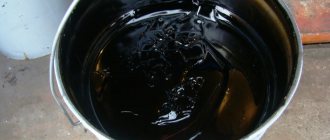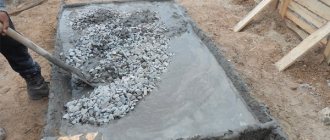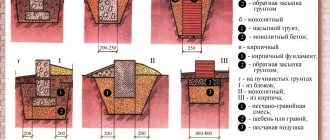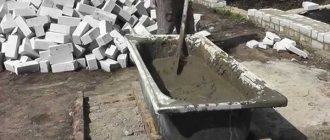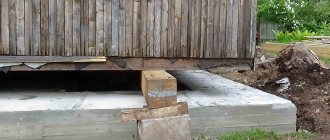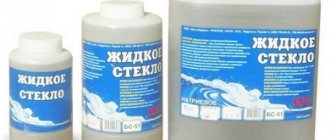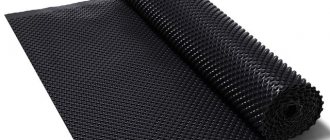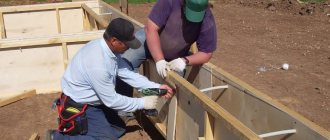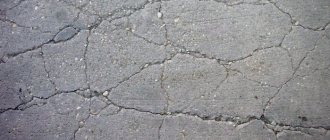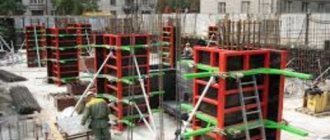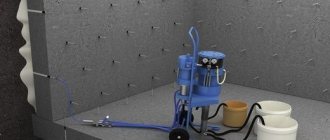Bitumen primer is a two-component substance, which includes bitumen mastic and solvent. Essentially, a primer is a primer solution used to create a strong bond between the mastic and the foundation.
Since the primer is more liquid than the waterproofing coating itself, it penetrates better into the concrete layer and forms a highly adhesive film on the working surface. In construction, primers are successfully used for priming surfaces before applying bitumen, polymer and any other built-up and rolled waterproofing materials.
Why prime the foundation?
Applying a primer
Primer - or in a more well-known definition, primer - is first applied to surfaces in order to prepare them for the installation of a waterproofing coating. The hygroscopicity of the foundation slab is due to the porosity of the material from which the foundation is made. Since most foundations are structures made of precast or monolithic concrete, bitumen mastics are widely used as waterproofing.
They are practical to use and exhibit excellent performance, but the main thing is that a master of any qualification can apply coating waterproofing.
Before applying waterproofing, the working surface is thoroughly cleaned of dust and dried. If necessary, due to the high porosity of the material, the primer solution is applied in two to three layers. For convenience, you should prime only that part of the structure to which the coating will be applied. It is recommended to carry out all subsequent work after the primer has completely dried.
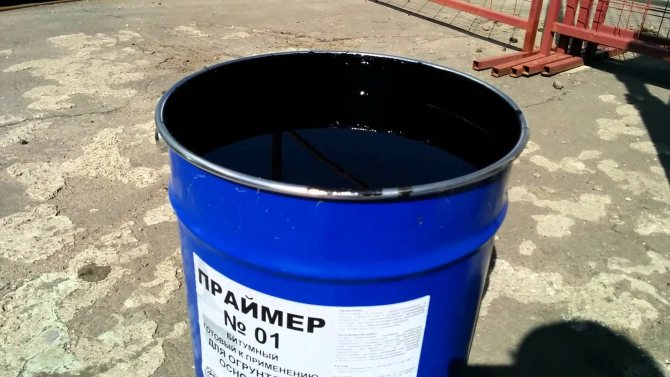
Priming the surface with various compositions is recommended to improve the adhesion of the base material and the working surface. The inappropriateness of priming the foundation before applying bitumen or polymer waterproofing is a common misconception. Coating primed surfaces allows you to speed up the process of installing waterproofing and save coating mastic due to preliminary impregnation of the concrete stone with a low-concentrated coating solution with a high degree of absorption. You need to choose a primer in accordance with the type of main waterproofing material.
Requirements for paints on concrete
High-quality, long-term surface protection can only be ensured by materials that meet the requirements and precise execution of the technologies for their use. Therefore, facade building materials used for painting the foundation plinth must fully comply with increased operational requirements:
- Adhesion to the base
. There are microparticles on almost any surface; they significantly reduce adhesion. Subsequently, when painting, they create unnecessary stress on the outer film, and this subsequently leads to its peeling. To eliminate harmful processes, the coating must be “absorbed” into the material as deeply as possible. To ensure favorable conditions, it is pre-treated with deep penetration primers for concrete. - Resistance to dampness
. Concrete is prone to quickly gaining moisture and is able to retain it for a long time. This leads to a significant reduction in the service life of paints and varnishes. Therefore, only facade technologies are used; they are purposefully developed using additives and additives. - High mechanical strength
. Resistance to abrasion, the ability to withstand damage from contact with other objects without critical damage and consequences, to withstand their moderate external influences, even impacts. - Lack of reaction to light
. We are talking not only about ultraviolet radiation, which destroys intermolecular bonds and promotes cracking, and then leads to paint peeling off from minor loads. Infrared radiation is taken into account, which stimulates paint fading and a change in the original color. - Vapor permeability
. Painting should protect against moisture, but prevent complete sealing of the base. Since it is undesirable to prevent the evaporation of condensate and the release of excess moisture. Otherwise, it accumulates, and during periods of significant temperature changes – thawing and freezing – it contributes to the destruction of materials. It is recommended not to paint the base with oil-based enamels, as they create a sealed layer that retains moisture. - Pollution resistance
. It should be understood that the important property of paint largely depends on the quality of surface preparation and appears at its best when conditions are created to obtain gloss. On a smooth surface, less dust settles and is retained, which when wet turns into dirt, creating a favorable nutrient medium for unpretentious vegetation. The glossy surface is easier to care for, and since the basement part is the very bottom of the house, located near the ground, quite a lot of dust settles on it - you have to often sweep it, keep it clean, and wash it. - The speed at which the outer film dries
to touch and reaches its calculated full strength. Atmospheric precipitation - exposure to humidity, temperature changes that stimulate the appearance of condensation, debris caused by the wind - all this has a detrimental effect on the fragile outer paint film. The less time it takes for the paint to dry, the better the subsequent protection. - Consumption
_ This is the main criterion for choosing any paints, but is especially relevant for painting concrete surfaces. After all, these are often large areas that require a large amount of paint. Moreover, it is almost impossible to perform high-quality painting at one time - usually at least two layers are required. - Manufacturability of dyeing
. It is assumed that high-quality painting is possible not only with a professional tool - a spray gun and a compressor. But also by any other methods available in everyday life - rollers, brushes. - Color saturation
. The ability to completely cover concrete and its color even with the first layer, without bald spots. This significantly reduces paint consumption. Its second layer should only increase the protective qualities, improve the appearance and visual appeal of the coating. - Price quality
. The total cost of the project – the estimated estimate – significantly depends on the selection of high-quality materials. Of course, the price of paint depends on the manufacturer’s brand, its composition and components. It can be influenced without loss of quality only by selecting it for specific operating parameters. It's either price or quality.
Types of primer
The primer is an integral part of the waterproofing coating, so before purchasing a batch of primer, you must make sure that the combined action of the two materials will not lead to a physical and chemical conflict. The ideal option for implementing a primer-mastic combination is the use of materials with similar composition and characteristics.
Usually, the same coating, largely diluted with a solvent, is used as a primer for bitumen mastic. Emulsions, acetate destructors or gasoline are used as solvents. Ready-made primers are created on an industrial scale and are low-concentrated bitumen mastic with an emulsifier.
In addition to the bitumen base, there are various acrylic and polymer primers that can also be used to strengthen the foundation surface before coating. There are several types of primer, depending on the coating material and solvent used:
- ready mixtures:
- by type of mastic: bitumen, acrylic, polymer;
- by type of solvent: acetate, gasoline, emulsion;
- prepared mixtures.
The most popular type of mastic is bitumen.
Price fluctuations in the primer market are determined by the quality of the mixture, as well as the cost of the original components. Making your own primer often means saving on quality rather than the cost of the final product. Only an experienced builder can correctly maintain the proportions, select non-conflicting components and mix a homogeneous solution. The money saved is insignificant and not worth the effort.
For the average person, it is preferable to purchase a ready-made mixture in accordance with the recommendation of the manager of the construction company from which the waterproofing material will be purchased.
Materials for coating waterproofing
To install coating waterproofing of foundations, special bitumen-based mastics, bitumen, cement-based compositions, and polymer materials are used.
Materials containing bitumen
In this group of waterproofing materials, bitumen comes first, but since... When using it, it requires heating, then due to the advent of new materials, its use is reduced.
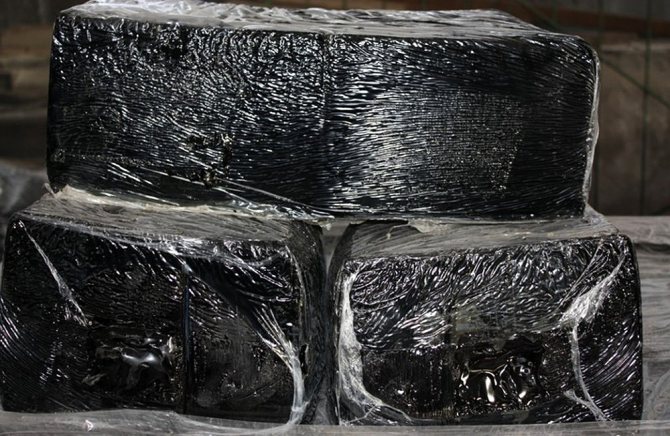
Solid bitumen will need to be heated before application.
Various plasticizers (rubber, silicone) and sealants are added to the composition of bitumen-based mastics, which improves their physical properties, performance characteristics, as well as the conditions for performing work using them. Bitumen-polymer mastics do not require preheating, but before applying them it is necessary to treat the surface to be coated with a special composition - a primer primer.
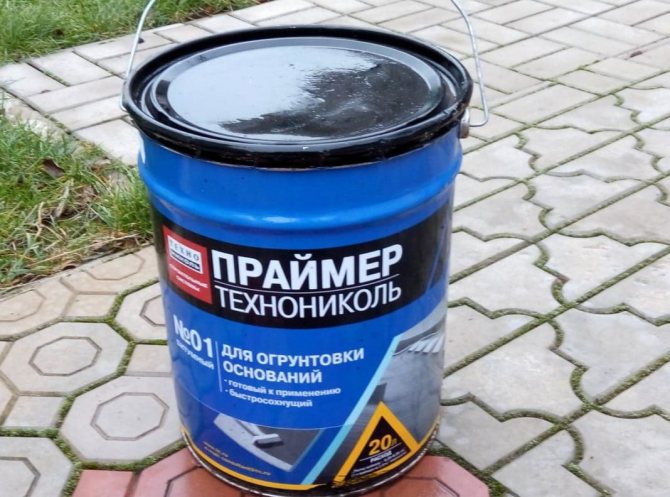
Primer for bitumen mastic
Primer - primer is applied to improve adhesion, strengthen the treated base and close pores on its surface. Primer primers are manufactured on mineral, bitumen, alkyd and acrylic bases and for various types of bases (concrete, brick, wood, etc.).
Mastics are produced as one-component ones, which can be used without additional preparation, and two-component ones, which require preparation for use.
For different types of bases, different brands of mastics are produced: for foundations and floors, under tiles, for roofing, as well as for parts of buildings and structures in contact with the ground.

Bituminous mastic that does not require heating
Cement based materials
Cement-polymer mastics include Portland cement, mineral fillers and polymerizing additives. These are two-component formulations, the preparation of which requires water or a special emulsion.
In addition, the industry produces mixtures that, in addition to cement, contain resins and inert fillers, as well as organic additives.
These materials are somewhat more expensive than those made on the basis of bitumen, but due to the fact that when performing work using them, the total volume of construction and installation work is reduced, the total cost of construction is almost identical for both options.
The reduction in the amount of work is due to the fact that the cement-based waterproofing layer also serves as a screed for the final coating of the treated surface.
Polymer materials
This group of waterproofing materials includes mastics made from synthetic emulsions, rubber, plasticizers and other technological additives.
Polymer mastics are much more expensive than materials based on cement and bitumen, but due to their technological performance, which is significantly superior to these materials, they are becoming increasingly widespread.
The advantages of polymer materials are:
- High adhesion to the surface to be coated.
- Elasticity.
- Absolutely waterproof.
- Fire safety.
Tools and materials used
Regardless of the choice of one or another type of primer, for preliminary preparation and subsequent application of waterproofing to the work surface, you may need the following equipment and materials:
- spatula or trowel;
- hammer, pickaxe;
- material for sealing joints - cement-sand mortar, polyurethane foam or putty;
- tools for preliminary cleaning of the primed surface: brushes, coarse dense cloth;
- container for calibrating the primer solution;
- wide brush or rough roller;
- primer
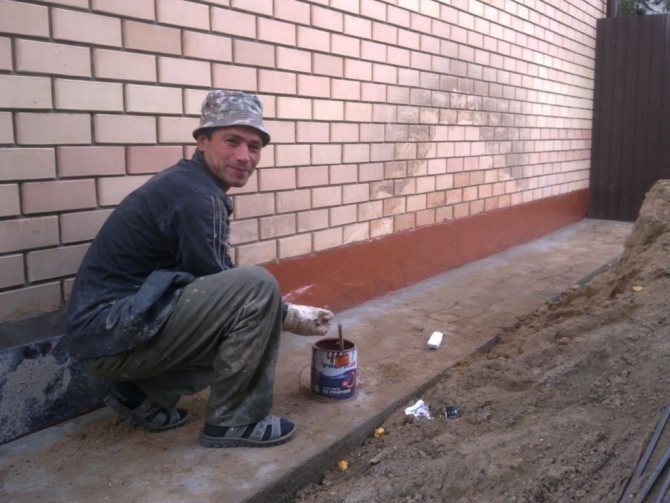
In addition, you should use protective equipment (overalls, headgear, closed tight shoes), since the primer is a bitumen mixture that is difficult to remove from clothing and skin.
Before directly applying the primer, the initial cycle should be carried out, without which the priming process will lose all meaning.
Surface preparation
The primer should only be applied to a dry and dust-free surface. In addition, before priming, seams should be sealed, irregularities and protrusions should be eliminated, for better adhesion and uniform distribution of the waterproofing layer. Expansion joints should be filled with polyurethane foam, since rigid sealing of such units is excluded. Protrusions and local layers of concrete larger than a centimeter should be removed using a hammer or pick. Concrete unevenness caused by bulging formwork or poor-quality joining of prefabricated elements should be filled with leveling mortar. Watch the video on how to prime a foundation.
These actions are especially relevant when installing waterproofing using rolled and weld-on materials in order to ensure the future integrity of the waterproofing layer and prevent ruptures at points of increased stress in the sheet.
After the sealed joints have hardened, you can begin to remove dust and apply a primer. Further actions are carried out only on the condition that all preparatory work has been completed properly and the surface has been primed in two to three layers, depending on the degree of porosity of the working surface.
Primer application technology
A primer is an ordinary primer with a special composition, so the technology for applying it is simple and straightforward. Regardless of the type of material chosen, the following steps should be taken to coat the foundation with a bitumen primer:
- stir the finished mixture or prepare a small amount of primer yourself in an easily transportable container;
- Apply the first layer of primer evenly to a surface cleaned of dust and moisture;
- wait for the first grip to dry and begin applying a layer of waterproofing on the next section of the foundation;
- after the first layer of primer has partially dried, apply a second layer, evenly distributing the solution;
- wait for the primer layer to dry completely in accordance with the period indicated by the manufacturer on the packaging.
Foundation primer must be applied in accordance with safety regulations. You should avoid getting the solution on exposed parts of the body - otherwise you need to remove the primer as quickly as possible using a solvent or regular soap before the substance polymerizes. Watch the video on how to properly prepare the primer for use.
It is also recommended to use protective masks, since bitumen primers are quite toxic, and due to the presence of a solvent and various dryers in the composition, the primer quickly polymerizes with a massive release of harmful substances into the atmosphere. It is especially not recommended to work with primer indoors without special personal protective equipment. Upon completion of work, clean the tools with solvent.
Paints for foundation and plinth
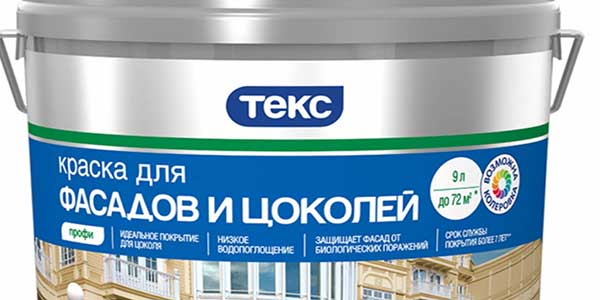
Naturally, foundation paint for concrete should be selected only from a range of high-quality, proven materials for exterior finishing. It’s not difficult to decide, since there is no shortage of materials, the range is large, almost all materials provide high-quality results that provide the necessary operating conditions:
- Acrylic facade paints
for stone, brick and concrete. The composition of polymer additives and acrylic resins, their concentration determines what the final result will be - gloss or matte surface, solvent - water. The coating itself protects surfaces well from the formation of fungus, resists the appearance of mold, the negative effects of chemical reagents and simply atmospheric precipitation, and forms a mechanically strong, durable, wear-resistant coating. At the same time, the painted surfaces still remain vapor-permeable, but at the same time they are moisture-resistant and frost-resistant. At the same time, they do not lose their original rich color for a long time. Before application, careful, thorough preparation of the surface is necessary before painting, but these difficulties are more than compensated for by the ease of application with available tools, and the moderate consumption of paint is pleasantly surprising. - Alkyd facade paints
for concrete and brick. Their composition is very fine mineral chips, alkyd resins as a binder. After application, at the moment of drying, polymerization occurs, an elastic but durable, smooth protective film is formed. It is possible to obtain a matte, semi-matte, or glossy surface, but the glossy option is recommended for concrete; it has the longest service life. However, alkyd paints for concrete require careful preparation of the base, do not accept violations in application technology, and the strength and durability of the coating proportionally depends on the accuracy of compliance. - Polyurethane facade paints
for concrete. Harden within two days after application, full strength is gained after 14 days. After which durable, resistant to mechanical stress, abrasion, and visually attractive glossy coatings are formed. - Silicone paints
. Optimal for processing porous surfaces. They give excellent results both when painting fresh and for protecting old materials, restoring dilapidated foundations that have lost their visual appeal, but are structurally sound.

A separate category of relatively new, so to speak, innovative materials includes rubber paint for concrete for exterior and facade work on a water-dispersed acrylic base. It relatively quickly gained the status of a reliable, durable coating with excellent performance properties. After application, the solution polymerizes into an elastic but durable film, and the painting process itself does not cause difficulties. On the contrary, production is quite specific; a considerable number of components are used:
- Acrylate latex, specially formulated to increase strength and elasticity, coalescent for film formation.
- Color schemes that define basic colors. Reagents, additives, fillers that improve performance properties.
- Antifreeze for frost resistance of the material.
- Preservative, against the formation of mold and fungi, increasing shelf life in closed packaging.
- Water – solvent, 5% of the total volume.
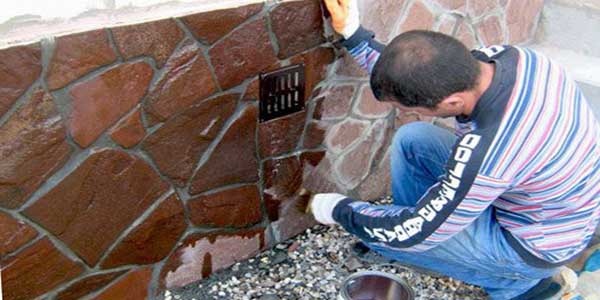
It is noteworthy that the material is environmentally friendly, harmless to people and the environment, both during operation and throughout the entire period of its operation. The rather complex composition of the concrete paint provided it with good performance properties:
- Application is as simple as possible, always in several layers.
- Increased adhesion.
- Short drying time.
- Improved vapor permeability.
- UV resistance.
- Wear resistance.
- Durability.
- Elasticity.
Calculation of primer volume
Based on the area of the surfaces to be treated, it is easy to calculate the required amount of primer. For ready-made mixtures, the material consumption per unit area is indicated on the packaging, taking into account the initial concentration. It is not recommended to further dilute factory mixtures, since the quality of the primer may deteriorate, and a conflict between the components being mixed is quite possible. The average consumption of bitumen primer is 0.5 liters per 1 m2.
If you are preparing the primer directly at the construction site, you should buy coating material with the expectation of using part of the coating to make the primer. Processing with such a mixture is not recommended for novice craftsmen.
In addition to the indicated consumption, to calculate the amount of the finished mixture, the number of layers applied should be taken into account. In the case of applying more than one layer of primer, the volume of the composition should be increased in an amount that is a multiple of the number of layers applied. For mixtures prepared by hand, it is difficult to calculate the required volume of primer, since the consumption will depend on the consistency of the primer.
Best Primer Brands
When choosing products for impregnating concrete surfaces, it is necessary to purchase those that are of good quality and have a long service life:
- Ceresit CT 17 - penetrates deep into the concrete layer and has good adhesive properties. Designed for application under plaster, wallpaper, panels, porcelain stoneware, tiles. While working, you need to use rubber gloves, as it has a negative effect on the skin of your hands.
- Optimist. It is easy to use, dries quickly, and produces a glossy surface.
- Lakra. Prevents the formation of fungus and mold on concrete. It is recommended to use for loggias, baths, and bathrooms, as it contains antibacterial additives.
- Prospectors. Inexpensive product that penetrates deeply. Can be used to further strengthen concrete floors.
- Knauf Tiefengrund. It has a universal effect, penetrates well into concrete, and is therefore suitable for moisture-resistant surfaces.
- Vetonit. The products have good value for money.
- Knauf Concrete contact. Polymer-based impregnation is recommended for use on surfaces with low absorbency.
When purchasing a primer, you must carefully read the instructions (it indicates the scope of application and technical characteristics of the surfaces to be treated).
